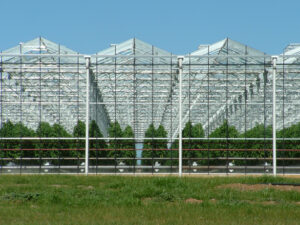
Transparent solar cells: Growing power
By John Fitzsimmons
Depending on location, energy usage can be the second largest operational expense in commercial greenhouse crop cultivation, and despite greenhouses providing the controlled environments needed for innovative research, they can be energy intensive and expensive to light, heat and cool. Transparent solar cells in greenhouses are emerging as an option to conventional energy systems.
Greenhouses can increase plant performance in tightly controlled climates, however, to counter glass’s poorer thermal insulation properties, heating and ventilation systems are installed to help maintain optimal conditions. These contribute to the house’s energy demands.
‘Agrivoltaics’ considers ways of incorporating solar cells into farms without sacrificing
arability. North Carolina State University (NCSU) has reportedly manipulated the wavelengths of light passing through a greenhouse roof using semi-transparent organic photovoltaics (OPVs) with specific optical coatings. Controlling the light transmission in certain parts of the solar spectrum can manipulate the chlorophyll content and the crop growth. Researchers reported no significant differences in the fresh weight and chlorophyll content of lettuce grown under organic cell filters across three harvest cycles.
This suggests that OPVs can fulfil the energy needs of the greenhouse, at no sacrifice to plant growth. OPVs can be applied as a semi-transparent thin glazing on the surface of large-scale greenhouses.
Traditional solar cells are currently a popular alternative to fossil fuels but still have their drawbacks. Photovoltaics are often composed using inorganic lead perovskites for their photoactive properties. Lead can be absorbed by plants and have means of entering the food chain.
UK company NextGen Nano, has also developed a patented transparent organic photovoltaic (OPV) device, PolyPower®, that can be used in the next generation of solar power. This technology is made from flexible, durable, Earth-friendly biopolymers. The aim of this technology is to replace the traditional brittle solar cells, made from toxin-heavy metals like lead perovskites.
Meanwhile, UK research with Light Science Technologies has found supplementary lighting in greenhouses can give up to a 12% crop yield increase in tomatoes.
Using LST’s nurturGROW® interlight and nurturGROW® high power top light, a five-month project trialled three different light combinations to see which produced the most yield for the least energy, while finding the optimum balance between energy and yield. The first regime consisted of interlighting only, the second regime, top lighting and interlighting, and the third was top lighting only.
The results showed that supplementary light increases crop yield by up to 12.1% even when used in summer months, and that top lighting only is the most energy efficient lighting regime with 38.2% more fruit per kWh. The trial also revealed that interlighting only was the top-performing light regime.
As input costs soar due to rising fuel and energy costs, there is agreement that growing more local produce and using less energy can be achieved through more productive light positioning. The trial showed the tangible gains and benefits of using an energy-efficient grow light on vine crops, with further energy saved, as the luminaire turns off when not needed. nurturGROW® also reduces light wastage with a recyclable and reusable design, making it more sustainable.
Light Science Technologies Ltd delivers lighting, science and research-proven plant monitoring technology and software in partnership with leading university research teams. It works across multiple indoor applications including vertical farming, greenhouses and poly tunnels, and across different plant species. The project was carried out in conjunction with CHAP at the Stockbridge Technology Centre (STC), at their Advanced Glasshouse facility in Selby, North Yorkshire.
More information:
Main photo: Imagine concurrent light transmission and power generation for the greenhouse. It could be possible with new nano coating technology (Image: John Fitzsimmons)
